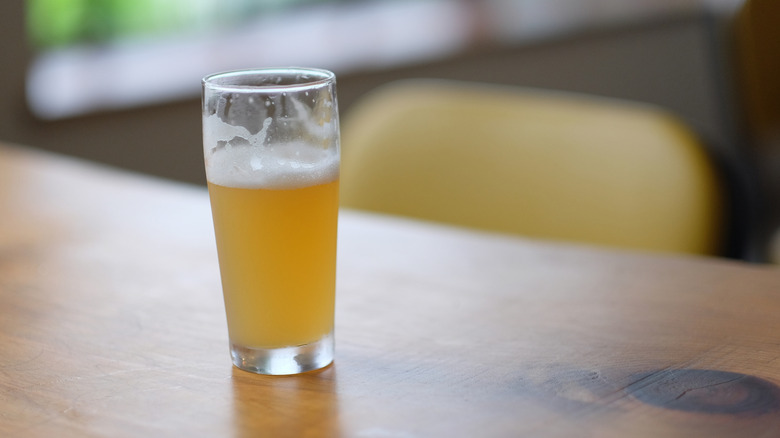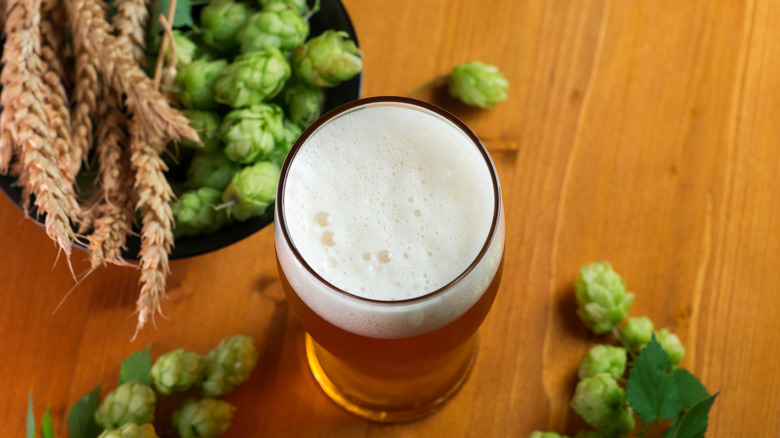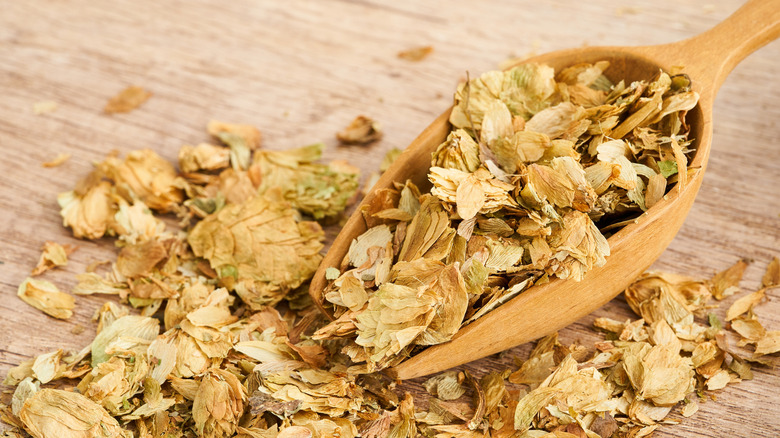Wet Vs Dry Hopping: What Do These Processes Do To India Pale Ales?
The rise of American craft beer introduced drinkers to a dizzying array of styles. Abandoning a lager-heavy focus, brewers reached for new ingredients and big flavors, creating products differentiated from domestics as craft beers. The initial vessel for such innovation was the IPA — short for Indian Pale Ale — a hop-heavy British style born in the 18th century. Remaining a modern mainstay, you'll find the beer in a wide range of sub-styles, defined by the hops and brewing technique.
To better understand IPA's nuance, you first have to understand the production process. An especially pivotal production step is the practice of wet vs. dry hopping. As a style defined by hops, the method of introduction of this aromatic ingredient makes a big difference.
Wet hopping relies on fresh-picked hops, which are full of moisture, hence lending the technique its name. The flowers can integrate into the beer during any production stage, even at the conclusion. On the other hand, dry hopping employs packaged and processed hops that are already dried. The dried hops enter beer later into production, used more prominently for the flavor and convenience of the technique. Both hopping styles contribute to unique IPA flavors and varieties, and contain regional ties. Plus, some brewers even combine them in unison for an especially aromatic result.
Wet hopping employs freshly harvested hops
Wet hopping is a much less common practice, by virtue of hop's delicate nature. Hop has an incredibly short shelf-life, with mold and deterioration occurring just days after it's picked. As a result, only brewers in hop-growing areas during harvest season have access to wet hopping. Typically, beer producers begin wet hopping the same day hops are collected.
The flowers are harvested from a vine, after experts verify the plant is ready for brewing. Freshly picked hops contain as much as 80% water, meaning they're far less flavor-dense than the more common dried hops. As a result, a much larger amount of hops per brew is required. However, when used in the right quantities, hops offer delicious vegetal, grassy, and fresh flavors, backed by a complex composition.
Although hops are the key ingredient that makes beer bitter, fresh hops showcase a different side to the plant. Beers using the wet hopping technique taste more plant-like, with an aromatic character that better reflects their origin. And while wet-hopping isn't used exclusively for IPAs, it does contribute an unmistakable character to the style. Hops are grown with regional varieties in specific locations; the Pacific Northwest is an especially high-profile region. So while certain brewers may overnight shipments out of the area, wet hopping generally upholds a more localized — and uniquely flavored — style of IPA production.
Dried hops are added later into the brewing process with dry hopping
In line with the name, dry hopping reaches for dehydrated hops to brew into IPAs. Due to their stable nature, the use of dried hops is much more common in the industry. After harvest, the flowers are dried and packaged, allowing for brewers to use them for several years after. Dry hopping doesn't just refer to the use of such hops, but rather specifies the fact that they are added later in the beer-making process. Dried hops exclusively contribute flavor rather than bitterness, and also offer preservative qualities.
Dry-hopping can occur during the fermentation or conditioning stage, and isn't essential to crafting an IPA. However, using the process imparts especially aromatic results. When hops are introduced during fermentation, they interact with yeast to promote certain flavor compounds. More commonly, the dried hops — often in the form of condensed pellets — go into the beer once it's cooled. There are many dry hopping techniques, all with the central aim of flavoring beer in distinct ways.
The process imparts a wide range of taste into IPAs, depending on both the type of hop variety and the duration of dry hopping. When brewed for a few days, a juicy, fruit-like character is imparted to the beer. Alternatively, if dry hops are added at the end of the brewing process, they reveal piney notes. And when hopped for especially long durations, the hop flavor softens, but still remains prevalent. Such variability grants brewers expansive IPA experimentation, opening the aromatic power of the hop even further.


